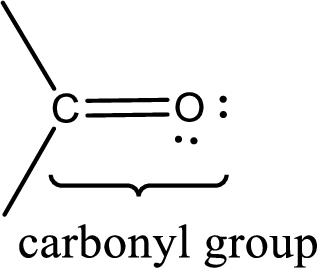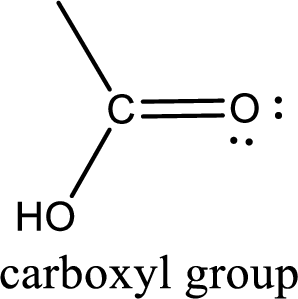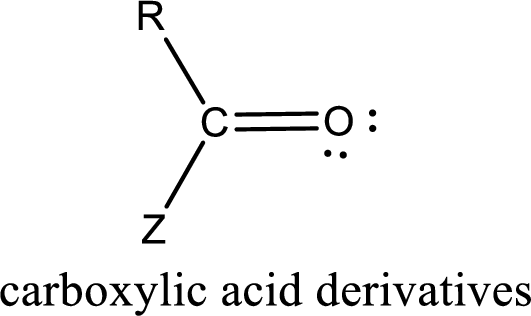
Organic And Biological Chemistry
7th Edition
ISBN: 9781305081079
Author: STOKER, H. Stephen (howard Stephen)
Publisher: Cengage Learning,
expand_more
expand_more
format_list_bulleted
Concept explainers
Question
Chapter 5.1, Problem 4QQ
Interpretation Introduction
Interpretation:
Concept Introduction:
Carbonyl groups are the one which contain a double bond between carbon and oxygen atom.

If a hydroxyl group is attached to a carbonyl group means it is known as carboxyl group. This can be represented as shown below,

Carboxylic acid derivatives are the ones that are synthesized from or converted to a carboxylic acid. The generalized structural representation of carboxylic acid derivatives is shown below,

Expert Solution & Answer
Want to see the full answer?
Check out a sample textbook solution
Students have asked these similar questions
Need help with these problems...if you can please help me understand problems E & F.
Please help me solve these problems. Thank you in advance.
Predict the products of this organic reaction:
O
N
IN
A
N
+ H2O + HCI ?
Specifically, in the drawing area below draw the skeletal ("line") structure of the product, or products, of this reaction. If there's
more than one product, draw them in any arrangement you like, so long as they aren't touching.
If there aren't any products because this reaction won't happen, check the No reaction box under the drawing area.
田
C
+
Explanation
Check
Click and drag to start drawing a
structure.
C
© 2025 McGraw Hill LLC. All Rights Reserved. Terms of Use | Privacy Center
Chapter 5 Solutions
Organic And Biological Chemistry
Ch. 5.1 - Prob. 1QQCh. 5.1 - Prob. 2QQCh. 5.1 - Prob. 3QQCh. 5.1 - Prob. 4QQCh. 5.1 - Prob. 5QQCh. 5.2 - Prob. 1QQCh. 5.2 - Prob. 2QQCh. 5.2 - Prob. 3QQCh. 5.2 - Prob. 4QQCh. 5.2 - Prob. 5QQ
Ch. 5.3 - Prob. 1QQCh. 5.3 - Prob. 2QQCh. 5.3 - Prob. 3QQCh. 5.4 - Prob. 1QQCh. 5.4 - Prob. 2QQCh. 5.4 - Prob. 3QQCh. 5.5 - Prob. 1QQCh. 5.5 - Prob. 2QQCh. 5.5 - Prob. 3QQCh. 5.6 - Prob. 1QQCh. 5.6 - Prob. 2QQCh. 5.7 - Which of the following statements about acid...Ch. 5.7 - Prob. 2QQCh. 5.7 - Prob. 3QQCh. 5.8 - Prob. 1QQCh. 5.8 - Prob. 2QQCh. 5.8 - Prob. 3QQCh. 5.8 - Prob. 4QQCh. 5.9 - Prob. 1QQCh. 5.9 - Prob. 2QQCh. 5.10 - Prob. 1QQCh. 5.10 - Prob. 2QQCh. 5.11 - Prob. 1QQCh. 5.11 - Prob. 2QQCh. 5.11 - Prob. 3QQCh. 5.12 - Prob. 1QQCh. 5.12 - Prob. 2QQCh. 5.12 - Prob. 3QQCh. 5.12 - Prob. 4QQCh. 5.13 - Prob. 1QQCh. 5.13 - Prob. 2QQCh. 5.14 - Prob. 1QQCh. 5.14 - Prob. 2QQCh. 5.14 - Prob. 3QQCh. 5.15 - Prob. 1QQCh. 5.15 - Prob. 2QQCh. 5.15 - Prob. 3QQCh. 5.16 - Prob. 1QQCh. 5.16 - Prob. 2QQCh. 5.16 - Prob. 3QQCh. 5.17 - Prob. 1QQCh. 5.17 - Prob. 2QQCh. 5.18 - Prob. 1QQCh. 5.18 - Prob. 2QQCh. 5.18 - Prob. 3QQCh. 5.19 - Prob. 1QQCh. 5.19 - Prob. 2QQCh. 5.19 - Prob. 3QQCh. 5.19 - Prob. 4QQCh. 5.20 - Prob. 1QQCh. 5.20 - Prob. 2QQCh. 5.20 - Prob. 3QQCh. 5.20 - Prob. 4QQCh. 5 - Prob. 5.1EPCh. 5 - Prob. 5.2EPCh. 5 - Prob. 5.3EPCh. 5 - Indicate whether or not each of the compounds in...Ch. 5 - Prob. 5.5EPCh. 5 - Prob. 5.6EPCh. 5 - Prob. 5.7EPCh. 5 - Prob. 5.8EPCh. 5 - Prob. 5.9EPCh. 5 - Prob. 5.10EPCh. 5 - Prob. 5.11EPCh. 5 - Prob. 5.12EPCh. 5 - Prob. 5.13EPCh. 5 - Prob. 5.14EPCh. 5 - Prob. 5.15EPCh. 5 - Assign an IUPAC name to each of the following...Ch. 5 - Prob. 5.17EPCh. 5 - Prob. 5.18EPCh. 5 - Prob. 5.19EPCh. 5 - Prob. 5.20EPCh. 5 - Prob. 5.21EPCh. 5 - Prob. 5.22EPCh. 5 - Prob. 5.23EPCh. 5 - Prob. 5.24EPCh. 5 - Prob. 5.25EPCh. 5 - Prob. 5.26EPCh. 5 - Prob. 5.27EPCh. 5 - Prob. 5.28EPCh. 5 - Prob. 5.29EPCh. 5 - Prob. 5.30EPCh. 5 - Prob. 5.31EPCh. 5 - Prob. 5.32EPCh. 5 - Prob. 5.33EPCh. 5 - Prob. 5.34EPCh. 5 - Prob. 5.35EPCh. 5 - Prob. 5.36EPCh. 5 - Prob. 5.37EPCh. 5 - Prob. 5.38EPCh. 5 - Prob. 5.39EPCh. 5 - Prob. 5.40EPCh. 5 - Determine the maximum number of hydrogen bonds...Ch. 5 - Prob. 5.42EPCh. 5 - Prob. 5.43EPCh. 5 - Prob. 5.44EPCh. 5 - Prob. 5.45EPCh. 5 - Prob. 5.46EPCh. 5 - Prob. 5.47EPCh. 5 - Prob. 5.48EPCh. 5 - Prob. 5.49EPCh. 5 - Prob. 5.50EPCh. 5 - Prob. 5.51EPCh. 5 - Prob. 5.52EPCh. 5 - Prob. 5.53EPCh. 5 - Prob. 5.54EPCh. 5 - Draw structural formulas for the following...Ch. 5 - Prob. 5.56EPCh. 5 - Give the IUPAC name for each of the following...Ch. 5 - Give the IUPAC name for each of the following...Ch. 5 - Prob. 5.59EPCh. 5 - Prob. 5.60EPCh. 5 - Prob. 5.61EPCh. 5 - Prob. 5.62EPCh. 5 - Prob. 5.63EPCh. 5 - Prob. 5.64EPCh. 5 - Prob. 5.65EPCh. 5 - Which three carboxylic acids have salts that are...Ch. 5 - Prob. 5.67EPCh. 5 - Which carboxylic acid has salts that are used to...Ch. 5 - Prob. 5.69EPCh. 5 - Prob. 5.70EPCh. 5 - Prob. 5.71EPCh. 5 - Prob. 5.72EPCh. 5 - Prob. 5.73EPCh. 5 - Prob. 5.74EPCh. 5 - Prob. 5.75EPCh. 5 - Prob. 5.76EPCh. 5 - Prob. 5.77EPCh. 5 - Prob. 5.78EPCh. 5 - Prob. 5.79EPCh. 5 - Prob. 5.80EPCh. 5 - Prob. 5.81EPCh. 5 - Prob. 5.82EPCh. 5 - Prob. 5.83EPCh. 5 - Prob. 5.84EPCh. 5 - Prob. 5.85EPCh. 5 - Prob. 5.86EPCh. 5 - Prob. 5.87EPCh. 5 - Prob. 5.88EPCh. 5 - Prob. 5.89EPCh. 5 - Prob. 5.90EPCh. 5 - Assign common names to each of the esters in...Ch. 5 - Prob. 5.92EPCh. 5 - Prob. 5.93EPCh. 5 - Assign an IUPAC name to each of the following...Ch. 5 - Draw a structural formula for each of the...Ch. 5 - Prob. 5.96EPCh. 5 - Prob. 5.97EPCh. 5 - Prob. 5.98EPCh. 5 - Prob. 5.99EPCh. 5 - Prob. 5.100EPCh. 5 - Prob. 5.101EPCh. 5 - How many carbon atoms are present in a molecule of...Ch. 5 - Prob. 5.103EPCh. 5 - Prob. 5.104EPCh. 5 - Prob. 5.105EPCh. 5 - Prob. 5.106EPCh. 5 - Prob. 5.107EPCh. 5 - Prob. 5.108EPCh. 5 - Prob. 5.109EPCh. 5 - Prob. 5.110EPCh. 5 - Prob. 5.111EPCh. 5 - Prob. 5.112EPCh. 5 - Prob. 5.113EPCh. 5 - Prob. 5.114EPCh. 5 - Prob. 5.115EPCh. 5 - Prob. 5.116EPCh. 5 - Prob. 5.117EPCh. 5 - Prob. 5.118EPCh. 5 - Prob. 5.119EPCh. 5 - Prob. 5.120EPCh. 5 - Prob. 5.121EPCh. 5 - Prob. 5.122EPCh. 5 - Prob. 5.123EPCh. 5 - Prob. 5.124EPCh. 5 - Write the structural formulas of the reaction...Ch. 5 - Prob. 5.126EPCh. 5 - Prob. 5.127EPCh. 5 - Prob. 5.128EPCh. 5 - Prob. 5.129EPCh. 5 - Prob. 5.130EPCh. 5 - Prob. 5.131EPCh. 5 - Prob. 5.132EPCh. 5 - Prob. 5.133EPCh. 5 - Prob. 5.134EPCh. 5 - Prob. 5.135EPCh. 5 - Prob. 5.136EPCh. 5 - Prob. 5.137EPCh. 5 - Prob. 5.138EPCh. 5 - Prob. 5.139EPCh. 5 - Prob. 5.140EPCh. 5 - Prob. 5.141EPCh. 5 - Prob. 5.142EPCh. 5 - Prob. 5.143EPCh. 5 - Prob. 5.144EPCh. 5 - Prob. 5.145EPCh. 5 - Prob. 5.146EPCh. 5 - Prob. 5.147EPCh. 5 - Prob. 5.148EPCh. 5 - Draw a condensed structural formula for the...Ch. 5 - Draw a condensed structural formula for the...Ch. 5 - Prob. 5.151EPCh. 5 - Prob. 5.152EPCh. 5 - Prob. 5.153EPCh. 5 - Prob. 5.154EPCh. 5 - Prob. 5.155EPCh. 5 - Prob. 5.156EPCh. 5 - Prob. 5.157EPCh. 5 - Prob. 5.158EPCh. 5 - Prob. 5.159EPCh. 5 - Prob. 5.160EPCh. 5 - Prob. 5.161EPCh. 5 - Prob. 5.162EPCh. 5 - Prob. 5.163EPCh. 5 - Prob. 5.164EP
Knowledge Booster
Learn more about
Need a deep-dive on the concept behind this application? Look no further. Learn more about this topic, chemistry and related others by exploring similar questions and additional content below.Similar questions
- 6. For each of the following, fill in the synthesis arrows with reagents and show the intermediates. You DO NOT need to use the same number of arrows that are shown (you may use more or less), but the product must be formed from the reactant. Then write the mechanism of one step in the synthesis (you can choose which step to write the mechanism for), including all reagents required, clearly labeling the nucleophile and electrophile for each step, and using curved arrows to show the steps in the mechanism. a. b. OHarrow_forwardDraw the productsarrow_forwardDraw the correct productsarrow_forward
- E Organic Chemistry Maxwell Draw the correct products, in either order, for the ozonolysis reaction: 1) O3, CH2Cl2, -78 °C Product 1 + Product 2 2) Zn, HOAc Draw product 1. Select Draw Templates More C H O presented by M Draw product 2. Erase Select Draw Templates M / # # carrow_forward✓ edict the products of this organic reaction: ---- ။ A CH3–C−NH–CH2–C−CH3 + KOH ? Specifically, in the drawing area below draw the condensed structure of the product, or products, of this reaction. If there's more than one product, draw them in any arrangement you like, so long as they aren't touching. If there aren't any products because this reaction won't happen, check the No reaction box under the drawing area. Explanation Check Click anywhere to draw the first atom of your structure. C 2025 McGraw Hill LLC. All Rights Reserved. Terms of Use | Privacy Center | Accessibiliarrow_forwardPredict the product of this organic reaction: A HO-C-CH3 + CH3NH2 P+ H2O Specifically, in the drawing area below draw the condensed structure of P. If there is no reasonable possibility for P, check the No answer box under the drawing area. Explanation Check Click anywhere to draw the first atom of your structure. marrow_forward
- H 1) OsO4, pyridine 2) Na2SO3 or NaHSO3 in H₂O 2 productsarrow_forward● Biological Macromolecules Naming and drawing cyclic monosaccharides Your answer is incorrect. • Row 1: Your answer is incorrect. Row 3: Your answer is incorrect. • Row 4: Your answer is incorrect. Try again... 0/5 Give the complete common name, including anomer and stereochemistry labels, of the following molecules. You will find helpful information in the ALEKS resource. CH2OH OH OH H H I H OH OH H] H CH2OH H OH ẞ-L-sorbose HOCH2 OH OH H HOCH2 H OH OH H OH H H CH2OH OH H H OH H I- H OH H OH Explanation Recheck W E R % 25 α B Y X & 5 D F G H McGraw Hill LLC. All Rights Reserved. Terms of Use | Pr Parrow_forwardWhat is the missing reactant in this organic reaction? + R -A HO IN + H₂O Specifically, in the drawing area below draw the skeletal ("line") structure of R. If there is more than one reasonable answer, you can draw any one of them. If there is no reasonable answer, check the No answer box under the drawing area. Note for advanced students: you may assume no products other than those shown above are formed. Explanation Check Click and drag to start drawing a structure. © 2025 McGraw Hill LLC. All Rights Reserved. Terms of Use | Privacy Centerarrow_forward
- Stuc X ctclix ALE X A ALE אן A ALEX Lab (195 X Nut x M Inb x NU X NUT X Unt x + → C www-awu.aleks.com/alekscgi/x/Isl.exe/10_u-lgNslkr7j8P3jH-IQ1g8NUi-mObKa_ZLx2twjEhK7mVG6PulJI006NcKTV37JxMpZuyrVCdQolLAKqp_7U3r1GUD3... New Chrome available: Naomi Question 26 of 39 (4 points) | Question Attempt: 1 of Unlimited Give the IUPAC name. 2,3-dimethylhexane Part: 1/2 Part 2 of 2 Draw the skeletal structure of a constitutional isomer of the alkane above that contains a different number of carbons in its longest chain. Skip Part Check Click and drag to start drawing a structure. 3 Finance headline Q Search mwa Harvard Intensifi... X Save For Later 00 dlo HB Submit Assignment 2025 McGraw Hill LLC. All Rights Reserved. Terms of Use | Privacy Center | Accessibility a 9:11 PM 4/22/2025arrow_forwardPredict the product of this organic reaction: + NH2 HO A P+ H2O Specifically, in the drawing area below draw the skeletal ("line") structure of P. If there is no reasonable possibility for P, check the No answer box under the drawing area. Click and drag to start drawing a structure. ✓arrow_forward个 Stuc X ctclix ALE X A ALE × A ALE X Lab x (195 × Nut x M Inbx EF 目 → C www-awu.aleks.com/alekscgi/x/Isl.exe/10_u-IgNslkr7j8P3jH-IQ1g8NUi-mObKa_ZLx2twjEhK7mVG6PulJI006NcKTV37JxMpz Chapter 12 HW = Question 27 of 39 (5 points) | Question Attempt: 1 of Unlimited Part: 1/2 Part 2 of 2 Give the IUPAC name. Check 3 50°F Clear ©2025 McGraw Hill L Q Search webp a عالياكarrow_forward
arrow_back_ios
SEE MORE QUESTIONS
arrow_forward_ios
Recommended textbooks for you
 General, Organic, and Biological ChemistryChemistryISBN:9781285853918Author:H. Stephen StokerPublisher:Cengage Learning
General, Organic, and Biological ChemistryChemistryISBN:9781285853918Author:H. Stephen StokerPublisher:Cengage Learning Organic And Biological ChemistryChemistryISBN:9781305081079Author:STOKER, H. Stephen (howard Stephen)Publisher:Cengage Learning,
Organic And Biological ChemistryChemistryISBN:9781305081079Author:STOKER, H. Stephen (howard Stephen)Publisher:Cengage Learning,

General, Organic, and Biological Chemistry
Chemistry
ISBN:9781285853918
Author:H. Stephen Stoker
Publisher:Cengage Learning

Organic And Biological Chemistry
Chemistry
ISBN:9781305081079
Author:STOKER, H. Stephen (howard Stephen)
Publisher:Cengage Learning,